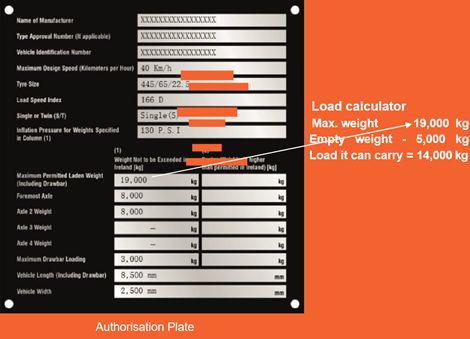Towing rules for agricultural tractors and trailers
Details about towing rules for agricultural tractors and trailers.
This content is for general information only. It does not, and is not intended to, provide legal or technical advice or to represent a legal interpretation of the matters it addresses.
Frequently asked questions
Check the manufacturer's plate as follows:

It is usually located in the cab under driver’s seat or over the brake pedal, but this may vary depending on the manufacturer.
You must adhere to the lesser of the two weights.
You are limited to towing a trailer with a DGVW of not more than three times the tractor’s unladen weight as specified by the manufacturer. Alternatively, you can contact the manufacturer or authorised distributor to have one fitted. You must always adhere to the lower weights declared on the manufacturer’s plate on the tractor or the authorisation plate on trailer.
To find out the maximum weight your trailer can carry, subtract the trailer’s unladen or empty weight from its maximum permitted weight as shown in the diagram below. However, the maximum weight cannot exceed the weight limits as outlined in S.I. No. 5/2003 - Road Traffic (Construction and Use of Vehicles) Regulations 2003. If you are still unsure, contact the vehicle manufacturer or authorised distributor.

On the side of the drawbar near front of trailer.
Find the unladen weight of your trailer from manufacturer or distributor or have it weighed and its volumetric carrying capacity.
Multiply the volumetric carrying capacity by the density of the crop being carried. Contact your local agricultural adviser who will assist with various crop densities.
Add the figure to the trailer’s unladen weight.
This will give an estimate of laden weight of trailer in kgs.
For example:
A 20ft (6.096 m.) tandem axle grain trailer with a volumetric capacity of 23 cubic metres (m3) and an unladen weight of 5,200 kg would weigh 22,450 kg when level-loaded with wheat:
Unladen weight + (carrying capacity x crop density) = loaded weight.
5 ,200 kg + (23 x 750) = 22,450 kg.
You can contact your local authority to find the nearest weighbridge to you.
All agricultural tractors and trailers first registered on or after 01 January 2016 must have a manufacturer’s plate fitted.
For further details on plating of agricultural vehicles see our FAQ. For more information download and read our Revised Standards for Agricultural Vehicles.
They will only need to be plated if:
- the agricultural tractor has a maximum design speed of more than 40 km/h or is being used to draw a tandem or tri-axle rigid drawbar trailer with a laden weight over 19 tonnes for tandems and 22.5 tonnes for triaxles.
- the agricultural trailer is capable by design of being drawn at speeds over 40 km/h or is operating at laden weights exceeding 19 tonnes for tandems and 22.5 tonnes for triaxles.